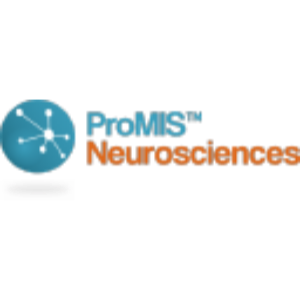ProMIS Neurosciences Announces Data on the Pathogenic Role of Toxic Misfolded SOD1 Aggregates in ALS Published in Acta Neuropathologica and Open Biology
Rhea-AI Summary
ProMIS Neurosciences (Nasdaq: PMN) announced the publication of two papers highlighting the role of toxic misfolded superoxide dismutase-1 (SOD1) aggregates in the pathogenesis of amyotrophic lateral sclerosis (ALS). The research, published in Acta Neuropathologica and Open Biology, supports targeting misfolded proteins as a therapeutic strategy for ALS.
Key findings include:
- SOD1 aggregates are present in both familial and sporadic ALS neural tissues
- A previously underappreciated SOD1 amyloidogenic region in β-strand II and III is important for aggregation and toxicity
- The existence of measurable SOD1 seeds across different forms of ALS contributes to the fundamental understanding of the disease
ProMIS is developing PMN267, an antibody targeting toxic misfolded TDP-43, as a potential ALS therapeutic. The research reinforces the company's broader strategy of targeting misfolded proteins in neurodegenerative diseases.
Positive
- Publication of research supporting ProMIS Neurosciences' therapeutic strategy in ALS
- Identification of SOD1 aggregates as potential biomarkers and therapeutic targets in both familial and sporadic ALS
- Development of PMN267 antibody targeting toxic misfolded TDP-43 for ALS treatment
Negative
- None.
News Market Reaction 1 Alert
On the day this news was published, PMN gained 18.33%, reflecting a significant positive market reaction.
Data tracked by StockTitan Argus on the day of publication.
Body of work supports targeting misfolded proteins as a therapeutic strategy for ALS with the potential to translate across multiple neurodegenerative diseases
CAMBRIDGE, Massachusetts and TORONTO, Ontario , Aug. 06, 2024 (GLOBE NEWSWIRE) -- ProMIS Neurosciences Inc. (Nasdaq: PMN), a biotechnology company focused on the generation and development of antibody therapeutics targeting toxic misfolded proteins in neurodegenerative diseases such as Alzheimer’s disease (AD), amyotrophic lateral sclerosis (ALS) and multiple system atrophy (MSA), today announced the publication of two papers highlighting the role of toxic misfolded superoxide dismutase-1 (SOD1) aggregates in the pathogenesis of ALS. One paper published in Acta Neuropathologica is titled, “Seeding activity of human superoxide dismutase 1 aggregates in familial and sporadic amyotrophic lateral sclerosis postmortem neural tissues by real-time quaking-induced conversion,” and the other publication in the online journal Open Biology is titled, “Amyloidogenic regions in beta-strands II and III modulate the aggregation and toxicity of SOD1 in living cells.”
ALS is a fatal neurodegenerative disease of motor neurons. Toxic aggregates of SOD1 and TAR DNA-binding protein 43 (TDP-43) in motor neurons are characteristic of ALS. As recently reported by ProMIS, these two proteins interact such that misfolding of TDP-43 leads to misfolding and aggregation of SOD1. ProMIS is currently developing PMN267, a humanized IgG1 antibody directed against toxic misfolded TDP-43 as a potential therapeutic for ALS.
The newly published research in Acta Neuropathologica reports on the seminal finding that aggregated SOD1 seeds are present in ALS neural tissues, not only in patients with SOD1 mutations, but also in patients with the most common sporadic form of the disease, which supports the relevance of misfolded SOD1 as a therapeutic target and as a potential biomarker of disease. The Open Biology publication highlights the importance of a previously underappreciated SOD1 amyloidogenic region in β-strand II and III to the aggregation and toxicity of SOD1 in ALS mutants, suggesting that β-strands II and III are potential targets for the development of SOD1-associated ALS therapies.
“This body of work advances the understanding of ALS disease biology and the importance of misfolded SOD1 aggregates in the pathogenesis of the disease. Furthermore, these studies reinforce the broader therapeutic strategy of targeting misfolded proteins in ALS and other neurodegenerative diseases driven by toxic protein aggregates,” stated Neil R. Cashman, M.D., Chief Scientific Officer and Co-Founder of ProMIS Neurosciences and an author on both publications.
As described in Acta Neuropathologica, the seeding activity of misfolded SOD1 aggregates in ALS neural tissues was measured using a real-time quaking-induced conversion (RT-QuIC) seed amplification assay system newly adapted to SOD1. Confirmation of the existence of measurable SOD1 seeds across different forms of ALS is an impactful contribution to the fundamental understanding of the disease. In addition, the observation that seeding activity was reduced after removal of misfolded SOD1from ALS tissue preparations with antibodies supports targeting SOD1 aggregates as a therapeutic approach.
The ProMIS platform is designed to identify target epitopes restricted to pathogenic forms of proteins including SOD1 and, as reported in Open Biology, in silico tools used to predict amyloidogenic regions in the ALS-associated SOD1-G85R mutant led to the identification of seven regions throughout the structure. Modifying the structure of these regions showed a reduction in the aggregation propensity and toxicity of SOD1-G85R, which supports their potential as a target for therapeutic intervention.
The complete articles can be accessed online here (Acta Neuropathologica) and here (Open Biology).
About ProMIS Neurosciences Inc.
ProMIS Neurosciences Inc. is a clinical stage biotechnology company focused on generating and developing antibody therapeutics selectively targeting toxic misfolded proteins in neurodegenerative diseases such as Alzheimer’s disease (AD), amyotrophic lateral sclerosis (ALS) and multiple system atrophy (MSA). The Company’s proprietary target discovery engine applies a thermodynamic, computational discovery platform - ProMIS™ and Collective Coordinates - to predict novel targets known as Disease Specific Epitopes on the molecular surface of misfolded proteins. Using this unique approach, the Company is developing novel antibody therapeutics for AD, ALS and MSA. ProMIS has offices in Toronto, Ontario and Cambridge, Massachusetts.
Forward-Looking Statements
This press release contains forward-looking statements that are made pursuant to the safe harbor provisions of the Private Securities Litigation Reform Act of 1995. Certain information in this news release constitutes forward-looking statements and forward-looking information (collectively, “forward-looking information”) within the meaning of applicable securities laws. In some cases, but not necessarily in all cases, forward-looking information can be identified by the use of forward-looking terminology such as “plans”, “excited to”, “targets”, “expects” or “does not expect”, “is expected”, “an opportunity exists”, “is positioned”, “estimates”, “intends”, “assumes”, “anticipates” or “does not anticipate” or “believes”, or variations of such words and phrases or state that certain actions, events or results “may”, “could”, “would”, “might”, “will” or “will be taken”, “occur” or “be achieved”. In addition, any statements that refer to expectations, projections or other characterizations of future events or circumstances contain forward-looking information. Specifically, this news release contains forward-looking information relating to the Company’s expectations regarding its development of its product, PMN 267, for ALS. Statements containing forward-looking information are not historical facts but instead represent management’s current expectations, estimates and projections regarding the future of our business, future plans, strategies, projections, anticipated events and trends, the economy and other future conditions. Forward-looking information is necessarily based on a number of opinions, assumptions and estimates that, while considered reasonable by the Company as of the date of this news release, are subject to known and unknown risks, uncertainties and assumptions and other factors that may cause the actual results, level of activity, performance or achievements to be materially different from those expressed or implied by such forward-looking information, including, but not limited to, the risk that the results of nonclinical studies are not necessarily predictive of future results with PMN267, the Company’s ability to fund its operations and continue as a going concern, its accumulated deficit and the expectation for continued losses and future financial results. Important factors that could cause actual results to differ materially from those indicated in the forward-looking information include, among others, the factors discussed throughout the “Risk Factors” section of the Company’s most recently filed Annual Report on Form 10-K for the year ended December 31, 2023 and in its subsequent filings filed with the United States Securities and Exchange Commission. Except as required by applicable securities laws, the Company undertakes no obligation to publicly update any forward-looking information, whether written or oral, that may be made from time to time, whether as a result of new information, future developments or otherwise.
For further information:
Visit us at www.promisneurosciences.com
Please submit media inquiries to info@promisneurosciences.com.
For Investor Relations, please contact:
Precision AQ
Anne Marie Fields, Managing Director
annemarie.fields@precisionaq.com
Tel. 212-362-1200









